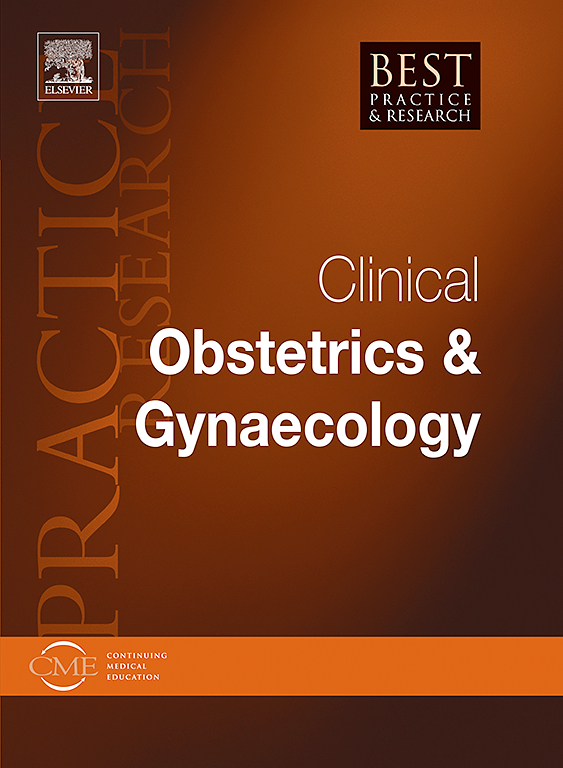Exploring new predictors for hypertensive disorders of pregnancy
IF 4.1
2区 医学
Q1 OBSTETRICS & GYNECOLOGY
Best Practice & Research Clinical Obstetrics & Gynaecology
Pub Date : 2025-03-27
DOI:10.1016/j.bpobgyn.2025.102598
引用次数: 0
Abstract
The best performing predicting Bayesian algorithm for preeclampsia, endorsed by FIGO, identifies high-risk women at first trimester screening who benefits of a closer monitoring and possibly preventive measures. Unfortunately, the most frequent late term and term preeclampsia are less efficiently predicted. This algorithm is based on statistical assumptions at odds with the physiopathology: preeclampsia is a disease and not a syndrome, as we know it is, and the contingent time-based criteria according to which all pregnancies if not terminated by nature should develop this “disease”.
In addition to this, we know that gestational hypertension might cause in fifty percent of cases severe outcome, comparable to preeclampsia. The very definition of preeclampsia as proteinuric hypertension is now extended to hypertension associated with other end-organ damage, including fetal growth restriction (FGR), this latter condition proceeding, in early onset cases, hypertension. Predicting phenotypes of hypertensive Disorders of pregnancy (HDP) could better help clinical practice.
This study reports exploratory observations in women resulted at high and low risk at first trimester screening followed up at second and third trimester, to term. The co-variates interrogated were sFlt1/PlGF ratio, the uterine arteries PI, the systemic vascular resistances (SVR), maternal total body water and visceral fat.
Women were classified as HDP-AGA, HDP-FGR, normotensive-FGR and uneventful pregnancies (controls). We performed a longitudinal Bayesian multivariate mixed-effects model corrected both for pre-gestational BMI and trimester of analysis.
The sFlt-1/PlGF ratio and SVR confirmed their significant difference in HDP-AGA, in normotensive FGR, and HDP-FGR along the three trimesters from controls, but with different strength along the three trimesters.
The bioimpedance analysis of total body water and visceral fat confirmed the association of these co-factors with women who will develop HDP-AGA.
The strength of longitudinal changes observed, even on a limited number of cases, provide evidence that Bayesian algorithms applied at screening tests at different gestational ages, should be based on co-variates significantly associated either with HDP-FGR or with HDP-AGA provided that the main causative co-factors involved are adopted by predictive models aimed at these distinct diseases.
探索妊娠期高血压疾病的新预测因子
FIGO认可的对先兆子痫表现最好的贝叶斯预测算法,在妊娠早期筛查中识别出高危妇女,她们受益于更密切的监测和可能的预防措施。不幸的是,最常见的晚期子痫和足月先兆子痫的预测效率较低。该算法基于与生理病理学不一致的统计假设:先兆子痫是一种疾病,而不是我们所知道的综合症,根据偶然的基于时间的标准,所有怀孕如果不是自然终止就会患上这种“疾病”。除此之外,我们知道妊娠期高血压可能会导致50%的严重后果,堪比先兆子痫。子痫前期作为蛋白尿高血压的定义现在扩展到与其他终末器官损伤相关的高血压,包括胎儿生长受限(FGR),在早发病例中,后一种情况发生,即高血压。妊娠期高血压疾病(HDP)的表型预测可以更好地帮助临床实践。本研究报告了对妇女的探索性观察结果,在妊娠中期和妊娠晚期的早期筛查中发现了高风险和低风险,直至足月。共变量包括sFlt1/PlGF比值、子宫动脉PI、全身血管阻力(SVR)、母体全身水分和内脏脂肪。将妇女分为HDP-AGA、HDP-FGR、正常血压- fgr和平安妊娠组(对照组)。我们进行了纵向贝叶斯多变量混合效应模型,对孕前BMI和妊娠期的分析进行了校正。sFlt-1/PlGF比值和SVR证实了他们在HDP-AGA、正常FGR和HDP-FGR方面与对照组在三个孕期有显著差异,但在三个孕期有不同的强度。全身水和内脏脂肪的生物阻抗分析证实了这些辅助因素与将发生HDP-AGA的妇女的关联。即使在数量有限的病例中,所观察到的纵向变化的强度也提供了证据,表明贝叶斯算法应用于不同胎龄的筛查试验时,应基于与HDP-FGR或HDP-AGA显著相关的共变量,前提是针对这些不同疾病的预测模型采用了所涉及的主要致病辅助因素。
本文章由计算机程序翻译,如有差异,请以英文原文为准。
求助全文
约1分钟内获得全文
求助全文
来源期刊
CiteScore
9.40
自引率
1.80%
发文量
113
审稿时长
54 days
期刊介绍:
In practical paperback format, each 200 page topic-based issue of Best Practice & Research Clinical Obstetrics & Gynaecology will provide a comprehensive review of current clinical practice and thinking within the specialties of obstetrics and gynaecology.
All chapters take the form of practical, evidence-based reviews that seek to address key clinical issues of diagnosis, treatment and patient management.
Each issue follows a problem-orientated approach that focuses on the key questions to be addressed, clearly defining what is known and not known. Management will be described in practical terms so that it can be applied to the individual patient.

 求助内容:
求助内容: 应助结果提醒方式:
应助结果提醒方式:


